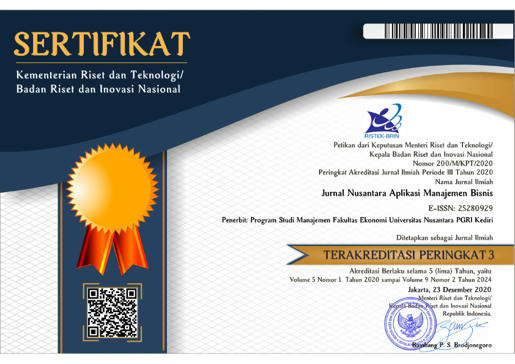Utilization Of Social Network Analysis To Analysis Content Beauty Influencer On The Twitter Application
DOI:
https://doi.org/10.29407/nusamba.v8i2.19596Keywords:
beauty influencer, skincare review, make-up tutorial, cosmetics, make-up challengeAbstract
Research Aim: This research was conducted to determine the interaction analysis of Beauty Influencer social networks on Twitter users who focused on beauty influencers.
Design/Method/Approach: This type of research was qualitative descriptive with the SNA method. Researchers use secondary data from Twitter—data collection techniques through data collection techniques, data preprocessing, analysis, and data visualization.
Research Finding: The results show that beauty influencers are connections with nodes that can build social networks between influencers and audiences.
Theoretical Contribution/Originality: This study's contributions can be used as a marketing strategy to increase the beauty business's competitiveness.
Practitioner/Policy Implication: The implication is to increase brand awareness because they get exposure from influencer followers, build audience trust in products, and increase sales.
Research Limitation: Further research on beauty influencer content should be conducted with different and more complete methods.
Downloads
References
D. A. Bisnis, “Influencer kecantikan Yordania dan pengaruhnya terhadap konsumen Mohammad Alawamleh * dan Sama Afghani,” vol. 6, no. 1, pp. 63–77, 2020.
D. C. U. Lieharyani and R. Ambarwati, “Visualisasi Data Tweet di Sektor Pendidikan Tinggi Pada Saat Masa Pandemi,” Build. Informatics …, vol. 4, no. 1, pp. 116–123, 2022, doi: 10.47065/bits.v4i1.1551.
S. R. I. Rezeki, “Penggunaan sosial media twitter dalam komunikasi organisasi (studi kasus pemerintah provinsi dki jakarta dalam penanganan covid-19),” J. Islam. Law Stud., vol. 04, no. 02, pp. 63–78, 2020.
A. M. Priyatno and L. Ningsih, “TF-IDF Weighting to Detect Spammer Accounts on Twitter based on Tweets and Retweet Representation of Tweets,” Sistemasi, vol. 11, no. 3, p. 614, 2022, doi: 10.32520/stmsi.v11i3.1995.
M. K. Bratawisnu and A. Alamsyah, “Social Network Analysis Untuk Analisa Interaksi User Di Media Sosial Mengenai Bisnis E-Commerce,” Sosiohumanitas, vol. 21, no. 1, pp. 63–69, 2019, doi: 10.36555/sosiohumanitas.v21i1.1000.
P. O. N. X. X. Papua, “6180-17498-1-Pb,” vol. 9, no. 1, pp. 282–301, 2022.
C. H. Karjo and S. Wijaya, “the Language Features of Male and Female Beauty Influencers in Youtube Videos,” English Rev. J. English Educ., vol. 8, no. 2, p. 39, 2020, doi: 10.25134/erjee.v8i2.2593.
A. Zukhrufani and M. Zakiy, “the Effect of Beauty Influencer, Lifestyle, Brand Image and Halal Labelization Towards Halal Cosmetical Purchasing Decisions,” J. Ekon. dan Bisnis Islam (Journal Islam. Econ. Business), vol. 5, no. 2, p. 168, 2019, doi: 10.20473/jebis.v5i2.14704.
Z. Beauty, “Beauty Index 2019,” 2019.
R. Savira and S. Zuhri, “RESEPSI PENONTON TERHADAP KONTEN REVIEW SKINCARE DALAM AKUN TIKTOK@ drrichardlee,” Linimasa J. Ilmu Komun., pp. 106–113, 2022, [Online]. Available: https://journal.unpas.ac.id/index.php/linimasa/article/view/4461
A. Y. Clara, A. Adiwijaya, and M. D. Purbolaksono, “Aspect Based Sentiment Analysis on Beauty Product Review Using Random Forest,” J. Data Sci. Its Appl., vol. 3, no. 2, pp. 67–77, 2020, [Online]. Available: http://commdis.telkomuniversity.ac.id/jdsa/index.php/jdsa/article/view/58
Z. F. Nurhadi, “Youtube Sebagai Media Informasi Kecantikan Generasi Millenial,” Commed J. Komun. dan Media, vol. 4, no. 2, pp. 170–190, 2020, doi: 10.33884/commed.v4i2.1585.
S. D. Sari and D. A. Yulianie, “Belum memiliki izin produksi tinjauan atas uu perlindungan konsumen,” pp. 156–168, 2020.
Y. I. Ligariaty and I. Irwansyah, “Narasi Persuasi Social Media Influencer Dalam Membangun Konsep Kecantikan Dan Kepercayaan Diri,” J. Pustaka Komun., vol. 4, no. 2, pp. 173–186, 2021, doi: 10.32509/pustakom.v4i2.1495.
S. Risyafani, J. Johannes, and ..., “THE EFFECT OF CONTENT REVIEW AND PROMOTION ON BUYING INTEREST WITH PRODUCT INVOLVEMENT AS AN INTERVENING:(Case Studies Of Tasya …,” J. Bus. …, vol. 5, no. 2, pp. 312–318, 2022, [Online]. Available: https://online-journal.unja.ac.id/jbsmr/article/view/18881%0Ahttps://online-journal.unja.ac.id/jbsmr/article/download/18881/13710
A. Budi Hapsari and P. Sari Sukardani, “Representasi Konsep Kecantikan Perempuan Di Era Millennials Melalui Beauty Influencer Pada Media Sosial Instagram,” Commercium, vol. 2, no. 2, pp. 59–62, 2018.
M. R. Adrian, M. P. Putra, M. H. Rafialdy, and N. A. Rakhmawati, “Perbandingan Metode Klasifikasi Random Forest dan SVM Pada Analisis Sentimen PSBB,” J. Inform. Upgris, vol. 7, no. 1, pp. 36–40, 2021, doi: 10.26877/jiu.v7i1.7099.
Imam Fahrur Rozi, Imam Fahrur Rozi, and Muhammad Balya Iqbal Alfahmi, “PENGEMBANGAN APLIKASI ANALISIS SENTIMEN TWITTER MENGGUNAKAN METODE NAÏVE BAYES CLASSIFIER (Studi Kasus SAMSAT Kota Malang),” J. Inform. Polinema, pp. 149–154, 2018.
V. N. Aini and A. Alamsyah, “Analisis Pada Peringkat Top Brand Menggunakan Jejaring Cosial Percakapan Dengan Social Network Analysis ( Studi Kasus Pada Smartphone Samsung , Blackberry , Nokia , Iphone di Indonesia ),” e-Proceeding Manag., vol. 3, no. 1, pp. 77–85, 2016.
N. A. R. Ichwan and Irwansyah, “Pesan Persuasi Beauty Influencer Pada Akun Youtube Tasya Farasya dalam Keputusan Pembelian Produk Kecantikan,” J u r n a l I l m u K o m u n i k a s i, vol. 10, 2021.
G. Ayu et al., “YOUTUBE TERHADAP MINAT BELAJAR MAKE UP REMAJA,” 2013.
D. Denada Octabella, S. Dwiyanti, S. Usodoningtyas, and D. Sinta Megasari, “Review Beauty Influencer Dalam Pengambilan Keputusan Konsumen Terhadap Pemilihan Produk Kosmetik Kecantikan Di Surabaya,” vol. 10, pp. 145–153, 2021, [Online]. Available: www.sociabuzz.com
Rahma and N. I. Idrus, “Tren Glow Up Challenge di Masa Pandemi Covid-19,” EMIK J. Ilm. Ilmu-Ilmu Sos., vol. 5, no. 1, pp. 23–46, 2022.
Downloads
Published
Issue
Section
License
Authors who publish with this journal agree to the following terms:
- Copyright on any article is retained by the author(s).
- The author grants the journal, the right of first publication with the work simultaneously licensed under a Creative Commons Attribution License that allows others to share the work with an acknowledgment of the work’s authorship and initial publication in this journal.
- Authors are able to enter into separate, additional contractual arrangements for the non-exclusive distribution of the journal’s published version of the work (e.g., post it to an institutional repository or publish it in a book), with an acknowledgment of its initial publication in this journal.
- Authors are permitted and encouraged to post their work online (e.g., in institutional repositories or on their website) prior to and during the submission process, as it can lead to productive exchanges, as well as earlier and greater citation of published work.
- The article and any associated published material is distributed under the Creative Commons Attribution-ShareAlike 4.0 International License












